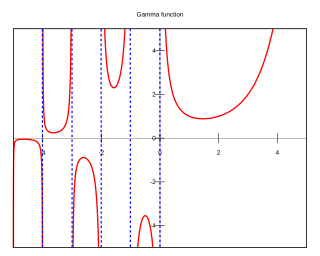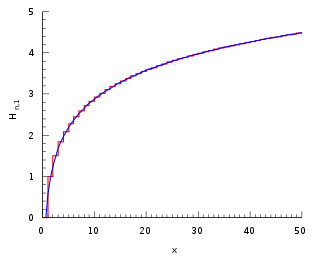
In mathematics, the gamma function is one commonly used extension of the factorial function to complex numbers. The gamma function is defined for all complex numbers except the non-positive integers. For every positive integer n,

The Riemann zeta function or Euler–Riemann zeta function, denoted by the Greek letter ζ (zeta), is a mathematical function of a complex variable defined as for , and its analytic continuation elsewhere.

Euler's constant is a mathematical constant, usually denoted by the lowercase Greek letter gamma, defined as the limiting difference between the harmonic series and the natural logarithm, denoted here by log:

In mathematics, the n-th harmonic number is the sum of the reciprocals of the first n natural numbers:

In mathematics, the polygamma function of order m is a meromorphic function on the complex numbers defined as the (m + 1)th derivative of the logarithm of the gamma function:

In mathematics, the digamma function is defined as the logarithmic derivative of the gamma function:

In mathematics, the Hurwitz zeta function is one of the many zeta functions. It is formally defined for complex variables s with Re(s) > 1 and a ≠ 0, −1, −2, … by

In mathematics, in the area of analytic number theory, the Dirichlet eta function is defined by the following Dirichlet series, which converges for any complex number having real part > 0:

In mathematics, the polylogarithm (also known as Jonquière's function, for Alfred Jonquière) is a special function Lis(z) of order s and argument z. Only for special values of s does the polylogarithm reduce to an elementary function such as the natural logarithm or a rational function. In quantum statistics, the polylogarithm function appears as the closed form of integrals of the Fermi–Dirac distribution and the Bose–Einstein distribution, and is also known as the Fermi–Dirac integral or the Bose–Einstein integral. In quantum electrodynamics, polylogarithms of positive integer order arise in the calculation of processes represented by higher-order Feynman diagrams.
In mathematics, the Lerch zeta function, sometimes called the Hurwitz–Lerch zeta function, is a special function that generalizes the Hurwitz zeta function and the polylogarithm. It is named after Czech mathematician Mathias Lerch, who published a paper about the function in 1887.

In mathematics, the Stieltjes constants are the numbers that occur in the Laurent series expansion of the Riemann zeta function:

In mathematics, the Barnes G-functionG(z) is a function that is an extension of superfactorials to the complex numbers. It is related to the gamma function, the K-function and the Glaisher–Kinkelin constant, and was named after mathematician Ernest William Barnes. It can be written in terms of the double gamma function.
In mathematics, the Glaisher–Kinkelin constant or Glaisher's constant, typically denoted A, is a mathematical constant, related to the K-function and the Barnes G-function. The constant appears in a number of sums and integrals, especially those involving gamma functions and zeta functions. It is named after mathematicians James Whitbread Lee Glaisher and Hermann Kinkelin.
In mathematics, the Riemann zeta function is a function in complex analysis, which is also important in number theory. It is often denoted and is named after the mathematician Bernhard Riemann. When the argument is a real number greater than one, the zeta function satisfies the equation It can therefore provide the sum of various convergent infinite series, such as Explicit or numerically efficient formulae exist for at integer arguments, all of which have real values, including this example. This article lists these formulae, together with tables of values. It also includes derivatives and some series composed of the zeta function at integer arguments.
In q-analog theory, the -gamma function, or basic gamma function, is a generalization of the ordinary gamma function closely related to the double gamma function. It was introduced by Jackson (1905). It is given by when , and if . Here ;\cdot )_{\infty }} is the infinite q-Pochhammer symbol. The -gamma function satisfies the functional equation In addition, the -gamma function satisfies the q-analog of the Bohr–Mollerup theorem, which was found by Richard Askey .
For non-negative integers n, where is the q-factorial function. Thus the -gamma function can be considered as an extension of the q-factorial function to the real numbers.

Carl Johan Malmsten was a Swedish mathematician and politician. He is notable for early research into the theory of functions of a complex variable, for the evaluation of several important logarithmic integrals and series, for his studies in the theory of Zeta-function related series and integrals, as well as for helping Mittag-Leffler start the journal Acta Mathematica. Malmsten became Docent in 1840, and then, Professor of mathematics at the Uppsala University in 1842. He was elected a member of the Royal Swedish Academy of Sciences in 1844. He was also a minister without portfolio in 1859–1866 and Governor of Skaraborg County in 1866–1879.
In discrete calculus the indefinite sum operator, denoted by or , is the linear operator, inverse of the forward difference operator . It relates to the forward difference operator as the indefinite integral relates to the derivative. Thus
In mathematics, the generalized polygamma function or balanced negapolygamma function is a function introduced by Olivier Espinosa Aldunate and Victor Hugo Moll.

In probability theory and directional statistics, a wrapped Cauchy distribution is a wrapped probability distribution that results from the "wrapping" of the Cauchy distribution around the unit circle. The Cauchy distribution is sometimes known as a Lorentzian distribution, and the wrapped Cauchy distribution may sometimes be referred to as a wrapped Lorentzian distribution.
In mathematical physics, the Wu–Sprung potential, named after Hua Wu and Donald Sprung, is a potential function in one dimension inside a Hamiltonian with the potential defined by solving a non-linear integral equation defined by the Bohr–Sommerfeld quantization conditions involving the spectral staircase, the energies and the potential . here a is a classical turning point so , the quantum energies of the model are the roots of the Riemann Xi function and . In general, although Wu and Sprung considered only the smooth part, the potential is defined implicitly by ; with N(x) being the eigenvalue staircase and H(x) is the Heaviside step function.



































